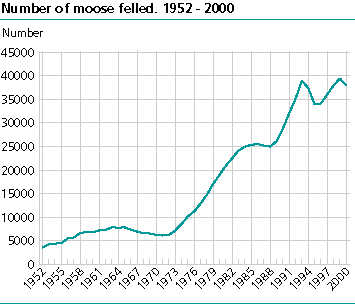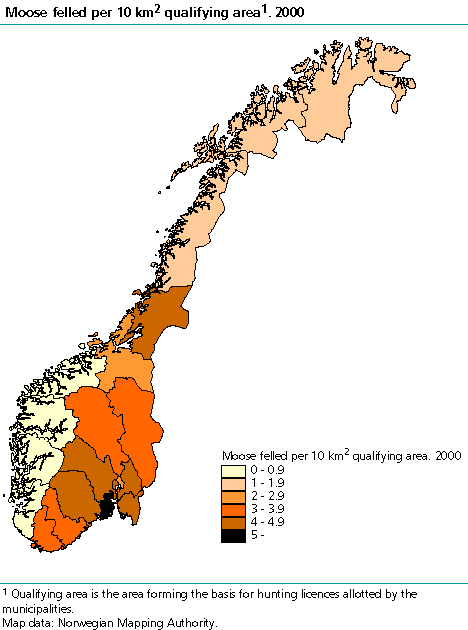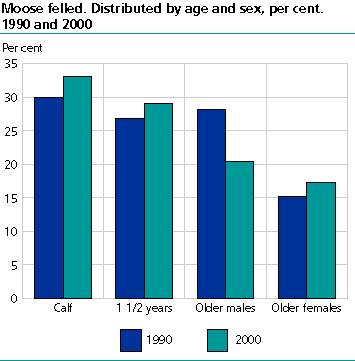Content
Published:
This is an archived release.
Decline for moose hunt
The number of moose hunted in Norway declined in 2000 after a record was set in autumn 1999. Thirty-eight thousand animals were felled in autumn 2000, 1 400 fewer than the year before. The felling percentage declined from 86 in 1999 to 84 in 2000.
The number of moose shot during the moose hunt rose from 3 600 in 1952 to a preliminary peak of 39 000 animals in 1993. The yield subsequently declined for a couple of years before rebounding to a new record of 39 400 animals in autumn 1999. A new decline was noted in autumn 2000. Thirty-eight thousand moose were felled, and this is 1 400 animals, or 3.6 per cent, fewer than in 1999. The felling percentage shows how many animals were shot as a percentage of the number of permits issued. Licences are issued by local wildlife authorities according to current moose stocks and future stock targets. High quotas are set when moose stocks need to be culled, and vice versa when numbers are low. Quotas are also set by the age and sex of the animals in order to achieve the desired composition of stocks. The felling rate is thus dependent on the size of the quotas and consequently does not directly reflect moose density. For 2000, licences were issued to shoot 45 200 moose nationwide. Of these, 84 per cent were shot.
In Oslo the felling rate was 103. A felling rate over 100 is not because hunters exceeded their assigned quotas, but because they have the opportunity to cooperate across municipal and county borders. During the autumn 2000 moose hunt, some of the animals for which permit were issued in Akershus, Oppland and Buskerud, were shot in Oslo. This situation also occurs in other counties.
Highest moose density in Vestfold
Hedmark is the county were most moose were shot: 6 744 moose were shot in Hedmark last autumn. This is 258 more than during the 1999 hunt. Moose density is, however, not the highest in Hedmark. By dividing the number of moose felled by the size of the area, Vestfold county has the highest density of moose. All of six animals were shot per 10 km2 of qualifying area in 2000. Telemark is in second place with 4.6 moose per 10 km2 of qualifying area. In addition to Hedmark, Sør-Trøndelag and Nordland saw a significant increase in the number of moose felled compared with 1999. The number shot was up by 181 and 106 respectively in these two counties in 2000. The largest percentage-wise increase occurred in Troms, where 80 more moose were felled than the year before. This amounts to an increase of 11 per cent. The largest decline was Buskerud, Oppland and Aust-Agder, where respectively 551, 479 and 419 fewer moose were shot in 2000 than in 1999.
Fewer bull moose
A third of the moose taken last autumn were calves, 29 were yearlings (18 mos.), 20 were older males and 17 per cent older females. This distribution is very similar to the past three years. Ten years ago, the percentage of adult bull moose was up to 28 per cent, while the other groups were two to three per cent under the current level.
Tables:
Contact
-
Terje Olav Rundtom
E-mail: terje.olav.rundtom@ssb.no
tel.: (+47) 91 38 60 61
-
Anne Turi Baklien
E-mail: anne.turi.baklien@ssb.no
tel.: (+47) 48 24 45 30



